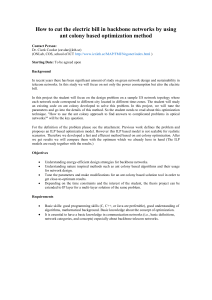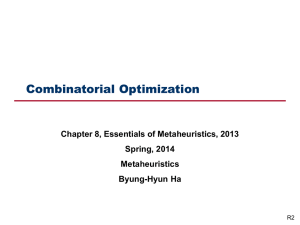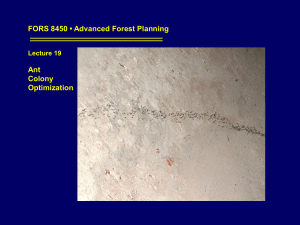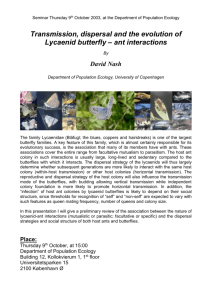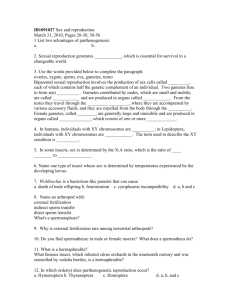Implementation of a Parallel Ant Colony Algorithm Using CUDA and
advertisement
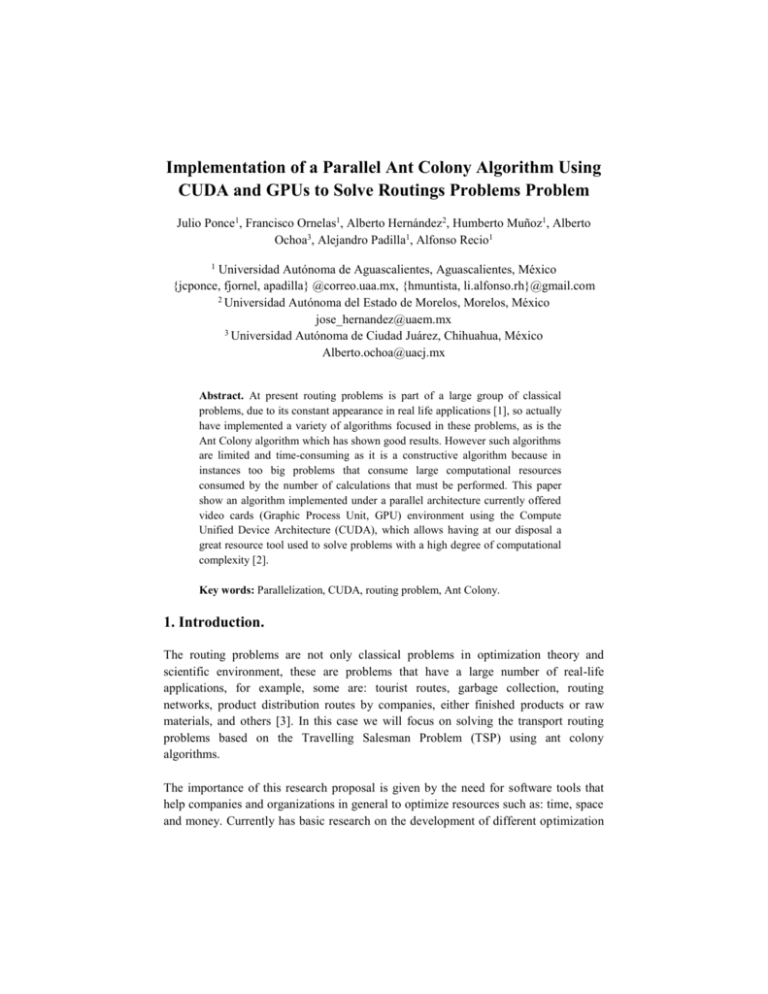
Implementation of a Parallel Ant Colony Algorithm Using
CUDA and GPUs to Solve Routings Problems Problem
Julio Ponce1, Francisco Ornelas1, Alberto Hernández2, Humberto Muñoz1, Alberto
Ochoa3, Alejandro Padilla1, Alfonso Recio1
1
Universidad Autónoma de Aguascalientes, Aguascalientes, México
{jcponce, fjornel, apadilla} @correo.uaa.mx, {hmuntista, li.alfonso.rh}@gmail.com
2
Universidad Autónoma del Estado de Morelos, Morelos, México
jose_hernandez@uaem.mx
3
Universidad Autónoma de Ciudad Juárez, Chihuahua, México
Alberto.ochoa@uacj.mx
Abstract. At present routing problems is part of a large group of classical
problems, due to its constant appearance in real life applications [1], so actually
have implemented a variety of algorithms focused in these problems, as is the
Ant Colony algorithm which has shown good results. However such algorithms
are limited and time-consuming as it is a constructive algorithm because in
instances too big problems that consume large computational resources
consumed by the number of calculations that must be performed. This paper
show an algorithm implemented under a parallel architecture currently offered
video cards (Graphic Process Unit, GPU) environment using the Compute
Unified Device Architecture (CUDA), which allows having at our disposal a
great resource tool used to solve problems with a high degree of computational
complexity [2].
Key words: Parallelization, CUDA, routing problem, Ant Colony.
1. Introduction.
The routing problems are not only classical problems in optimization theory and
scientific environment, these are problems that have a large number of real-life
applications, for example, some are: tourist routes, garbage collection, routing
networks, product distribution routes by companies, either finished products or raw
materials, and others [3]. In this case we will focus on solving the transport routing
problems based on the Travelling Salesman Problem (TSP) using ant colony
algorithms.
The importance of this research proposal is given by the need for software tools that
help companies and organizations in general to optimize resources such as: time, space
and money. Currently has basic research on the development of different optimization
algorithms such as: Genetic Algorithms (GA), Ant Colony Optimization (ACO),
Estimation of the Distribution Algorithms (EDAs), among others. In particular Ant
Colony Algorithms are based on the way how they create short routes from their anthill
to a food source [4], these algorithms have been shown to give good results in a variety
of applications among which are the TSP problems and the knapsack problem, however
these algorithms are limited in their implementation due to teams where they test, so it
is critical to integrate them into a system to process instances of these problems, with
order to contribute more in the scientific as well as real applications that support the
development of companies within the entity. This would be possible if there were
equipment for testing on multiprocessor architectures / multi-core, using the advantages
offered by parallel processing for several of these algorithms.
It is a fact that businesses have the need to be ever more competitive, so you need to
implement and seek new software tools that enable them to meet their goals, the
programming of these algorithms in a parallel on multiprocessor architectures /
multicore can be the solution to various problems industries or public institutions.
On the other hand there is the possibility to exploit the processing power of the new
supercomputers that incorporate multiple microprocessors and GPUs, which represent
an increase in the number of processes performed by the current computer systems in a
short space of time, which encourages high energy savings and increased processing
speed parallelizable algorithms, also is has a large number of algorithms for solving
NP-Hard problems developed by leading researchers worldwide that can be applied to
solve a variety of real-world problems.
The importance of this project lies in the proposal to parallelize the algorithms which
have worked today, which will be developed and technology work on multiprocessor /
multicore, that can take its theoretical context to different real applications. While there
are several software tools, proprietary or free, for the same purpose many of them
become prohibitive in terms of cost, technical support or infrastructure required to run
the processes, more importantly, do not incorporate new trends and new algorithms
with due expedition, so in this paper is to bring these algorithms to a parallel
environment GPU with CUDA architecture that will allow communication between
processes performed between processors and GPU's environment will have advantages
in time and cost on the use of parallelization used in parallel processing environments
processors and cores.
2. State of the Art.
2.1 Graphics Processing Unit and CUDA
CUDA (Compute Unified Device Architecture) is a parallel processing architecture
company created by the NVIDIA graphics card manufacturer that aims to harness the
processing power of a GPU to achieve increases in performance of the system with
which it develops. Found practical applications for this technology in such areas as
simulation, video processing, astrophysics, computational biology and chemistry, fluid
mechanics, electromagnetic interference, or seismic analysis, ray tracing among others
[5].
Figure 1. Representation of processing units between CPU and GPU.
Figure 1 Is a representation of the amount of processing units that comprise a CPU and
GPU on which there is a clear superiority in numbers of units for testing this work we
used a GPU with 448 cores. With CUDA CPU often performs the task manager
instructions and information will be stored and processed in the GPU memory and once
this process will return the information to the CPU memory to display results only.
2.2 Ant Colony Algorithm
To carry out the research work we use an Ant Colony algorithm to tackle routing
problems. This algorithm simulates the behavior of ants in real life, based on how they
generate routes from their nest to a food source. Ants communicate by traces of
chemicals called pheromones, which lay on the road and will guide through these, the
most promising routes are being left with higher pheromone trail to the other [6].
The ant colony algorithms have been used to solve different combinatorial optimization
problems, in the algorithm each ant is an agent that can have a simple behavior but not
always find quality roads alone, is why is communicated overall the pheromone
through [7]. The algorithm used is as follows.
It makes use of the ACO method for solving the problem.
Parameter Initialization
Read instance of the problem
Set initial pheromone
repeat
Generate Ants
For k from 1 through the number of ants Make
Build a solution for ant k
Select the best solution
Update pheromone trails
To Reach the number of iterations
Where the parameters are the number of ants, α: importance of the pheromone, β:
importance of visibility, ρ: rate of evaporation of pheromone, τ: initial concentration of
the pheromone and the given problem instance by reading file.
Build Solution
For the construction of the solution to each ant is placed in an initial position and from
that point is required to get the chance to go to the next step, each path is obtained
using the following equation:
where:
τij: the pheromone concentration of point i and point j.
nij: inverse arc distance between the point i and point j.
so that the probability that k fence ant the damn points i j is given in function of the
concentration of the pheromone and distance.
Update pheromone trails
Pheromone updating is performed by the following equation:
τij(t+1)=ρ τij(t)+Δτ
where:
τij (t +1): amount of pheromone for the next iteration
ρ: the pheromone evaporation
τij (t): amount of pheromone present
Δτ: increased pheromone
3. Implemented Algorithm.
We developed first ant colony algorithm sequentially, once with the complete
algorithm proceeded to conduct an analysis of each of the steps in order to determine
which procedures are dependent on one another, these processes may not be candidates
to perform in parallel, and what procedures are independent of these processes are part
of the candidates to run in parallel. A first approximation of the parallel
implementation of the algorithm can be seen in [8], however only initializations
implemented in parallel and where there are functions that are mathematical
calculations that can reduce the execution time considerably.
In this work we were able to parallelize processes: distance calculation used instance,
placing the initial pheromone, pheromone updating and calculating the probability of
cities to each ant. The functions performed under CUDA is shown in the following
code.
/************** Start CUDA Functions *************/
/* Get the distance matrix and pheromone*/
__global__ void distanceKernel( float *x, float *y, float *d, float *ph int n)
{
float dx, dy;
int i = threadIdx.x+blockIdx.x*blockDim.x;
int j = threadIdx.y+blockIdx.y*blockDim.y;
dx = x[i] - x[j];
dy = y[i] - y[j];
d[j+i*n] = sqrt(pow(dx,2)+pow(dy,2));
ph[j*n+i] = ph[i*n+j]= ph_base;
}
/* Get the sum of every TijNij */
__global__ void sumTijNijKernel(float *c, float *p, float *res, int n, int a, int b)
{
//c-> city distance
//p-> pheromone
int i = threadIdx.x+blockIdx.x*blockDim.x;
if(i<n)
res[i]= (float)pow(p[i],a) * (float)pow(c[i],b);
}
__global__ void tijNijKernel(float *c, float *p, float *tn, int n, int a, int b, float sum)
{
//c-> city distance
//p-> pheromone
int i = threadIdx.x+blockIdx.x*blockDim.x;
if(i<n)
tn[i]= (float)((float)pow(p[i],a) * (float)pow(c[i],b)/sum);
}
/************** End CUDA Functions ***************/
4. Results.
It implements an Ant Colony algorithm for solving a TSP in parallel using CUDA
architecture, it has several. Tsp benchmarks files which are located on the TSPLIB
instances that are used as an example for this type of problem [9].
The experiments were performed with the following values for the instances of the
problem:
50 iterations, α 1, β: 5, ρ: 0.01, τ: 0.001, Δτ = 1.01
Burma14.tsp the file shown in Table 1 was obtained the result shown in Figure 2
Table 1. File burma14.tsp
Figure 2. Results of the program to the file burma14.tsp
While for ulysses22.tsp file shown in Table 2 was obtained the result shown in
Figure 3.
Table 2. File ulysses22.tsp
Figure 3. Results of the program to the file ulysses22.tsp
5. Conclusions and Future Work.
In this paper proposed the implementation of an ant colony algorithm in parallel using
CUDA architecture provides us giving us the advantage of using the resources of both
the CPU and GPU's computer which we can face greater problems of computational
complexity index with a response time less than they would in parallel systems that
work only with computers CPU and sequential programming because the GPU's today
have more core for processing data compared to current CPU, which means that each
of them can work with a portion of the work to be performed, leading to less time
consuming in solving the problem.
The resulting system of this project is to make available to the academic and scientific
community for free, and in due course can be considered for transfer to companies
through the development of systems tailored to the needs of each of the business
requires.
As future work is to conduct a comparative study on the execution speed of the
algorithm with respect to the best solution found, to determine what percent the speed
of the algorithm improves the best result.
Acknowledgements.
This work was partially
PROMEP/103.5/12/3780.
supported
by
the
SEP
through
the
project
References.
[1] de la Fuente D., Lozano J., Ochoa E. & Díaz M.: Estado del arte de algoritmos basados en
colonias de hormigas para la resolución del problema VRP. XV Congreso de Ingeniería de
Organización Cartagena, (2011).
[2] Laguna G., Olguín M, Barrón R.: Introducción a la programación de códigos paralelos con
CUDA y su ejecución en un GPU multi-hilos. (2011).
[3] Ponce J., Quezada F., Hernandez A., Correa C.: Logistics for the Garbage Collection through
the use of Ant Colony Algorithms. En Logistics Management and Optimization through
Hybrid Artificial Intelligence Systems Edite by: Carlos Alberto Ochoa Ortiz Zezzatti.
Publisher: IGI. ISBN13: 9781466602977, (2012).
[4] Barán B. & Almirón M.: Colonia de Hormigas en un Ambiente Paralelo Asíncrono. XXVIII
Conferencia Latinoamericana de Informática CLEI’2002, Montevideo - Uruguay, (2002).
[5] Corporation Nvidia. (2006) CUDA Computer Parallel Computing Platform. Consultado en
mayo de 2012. https://developer.nvidia.com/what-cuda
[6] Dorigo M., Maniezzo V., Colorni A.: Ant system: optimization by a colony of cooperating
agents. IEEE Transactions on Systems, Man, and Cybernetics, Part B 26(1): 29-41, (1996).
[7] Ponce J., Padilla F., Ochoa A., Padilla A., Ponce de León E., Quezada F.: Ant Colony
Algorithm for Clustering through of Cliques. Artificial Intelligence & Applications. Gelbukh
(Ed.): SMIA. ISBN-978-607-95367-0-1. pp. 29–34, 2009.
[8] Ponce J., Hernandez A., Ochoa A., Quezada F., Ponce de León E. & Zavala C.: Solving
Routing Problems Using Ant Colonies Optimization, and a Parallel Architecture with GPUs.
Book: Logistic: Perspectives, Approaches and Challenges, Edited by: Jinghua Cheung and
Huan Song, Nova Publishers, ISBN: 978-1-62618-087-1, (2013).
[9] TSPLIB. Librería en internet con benchmarks reconocidos para problemas de ruteo.
http://comopt.ifi.uni-heidelberg.de/software/TSPLIB95/ consultado abril de 2012.
